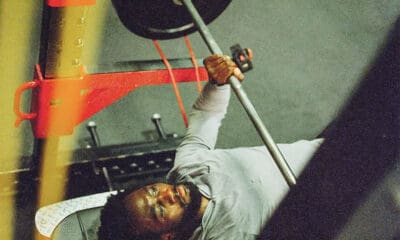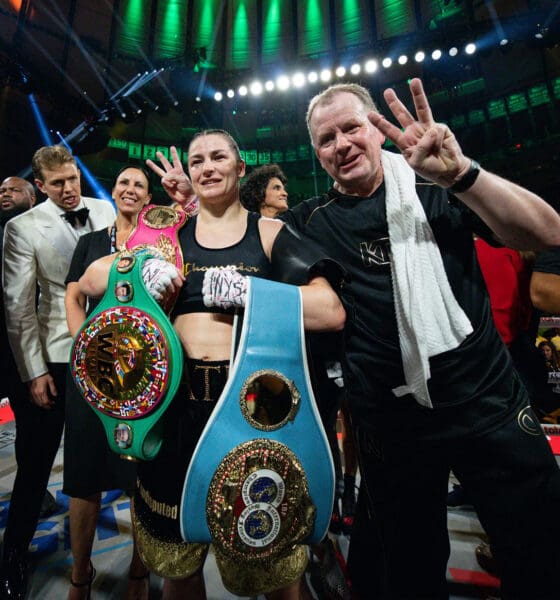-

 Worldwide
WorldwideSplit-Second Calls That Defined Title Fight Legacies
In championship boxing, the referee is the third man with the power to change everything. Unlike judges, who add up rounds over 36 minutes, the referee...
-

 Announcements
AnnouncementsWorld Boxing Schedule: Dzambekov Returns, Final Bell for Braekhus, BKFC82
It’s a light boxing schedule, but there is action if you know where to look. Fortunately, NY Fights knows. Dzambekov Leads 360 Boxing Card Friday Light...
-

 Boxing
BoxingThe Final Bell Rings For Cecilia Braekhus October 4
As the first woman to become an undisputed world champion in the four-belt era of boxing, Cecilia Braekhus of Norway is guaranteed to enter the International...
-

 Boxing
BoxingUmar Dzambekov: Austria’s Most Famous Boxer Returns Oct. 3
If you were asked to name famous athletes from Austria, you might name a skier or a Formula 1 driver. You might think of a certain...
-

 Boxing
BoxingAmerican Dante Stone Makes WBC Grand Prix Semis
Arizona heavyweight Dante Stone (21-1, 13 KOs) is the final American boxer and one of 16 fighters left competing in the semifinals of the inaugural World...
-

 Boxing
BoxingWorldwide Boxing Schedule for Sept 27: MVP, ProBox, BKFC 81
It may not seem like there’s much on the boxing schedule for September 27, but there are tasty bites for fans from around the world if...
-

 Boxing
BoxingTiara Brown Wears the Crown, But Stays On The Grind
Women’s sports including women’s boxing is a having a moment. If you ask WBC World Featherweight champion Tiara Brown of Fort Myers, Florida, it’s about time....
-

 Boxing
BoxingNetflix Reports Canelo vs Crawford Numbers
The viewer numbers are in from Netflix for Saturday’s history-making Canelo vs Crawford fight card, aired live on Netflix from Allegiant Stadium in Las Vegas. While...
-

 Worldwide
WorldwideCanelo vs Crawford: Official Weigh-In Results
Like watching jockeys saddle up in the paddock and take the post parade to the track, the boxing weigh-in provides the final clues about the outcomes...
-

 Boxing
BoxingLewis Crocker vs Paddy Donovan 2: The Dramatic Story So Far
Lewis Crocker of Belfast, Northern Ireland (21-0, 11 KOs) will take on Paddy Donovan of Limerick, Ireland (14-1, 11 KOs) on Saturday when the pair compete...
-

 Boxing
BoxingTerence Crawford’s Super Middleweight Sparring Partner Previews Canelo Super Fight
Terence Crawford of Omaha (41-0, 31 KOs) will compete in one of the biggest fights of his life on Saturday night when he takes on fellow...
-

 Boxing
BoxingSugar Núñez Survives Challenge By Pitufo Diaz
IBF World Super Featherweight champion Eduardo ‘Sugar’ Núñez delivered the victory his devoted Sinaloa fans wanted in a homecoming fight Saturday night, but it wasn’t a...
-

 Boxing
BoxingSugar Núñez, Oscar Valdez: Sweet Boxing Doubleheader From Mexico
IBF World Super Featherweight champion Eduardo ‘Sugar’ Núñez is now part of the boxing legacy of Los Mochis, Sinaloa, Mexico. In this coastal city, hugging the Sea...
-

 Boxing
Boxing9 Top Fight Cards On Fall 2025 Boxing Schedule
Whether you already have a pumpkin spice latte in your hand or not, fall has arrived in the Northern Hemisphere. It’s a time when the 2025...
-

 Boxing
BoxingMoses Itauma Smokes Dillian Whyte, A Heavyweight Star Is Born Saturday
Consider me firmly aboard the hype train in a first-class seat. A heavyweight star was born Saturday in Riyadh, Saudi Arabia, and his name is Moses...
-

 Boxing
BoxingUndercard Recap: Filip Hrgovic Survives, Ray Ford Thrives in Riyadh
Early action in Riyadh on the Itauma vs Whyte undercard delivered solid competition, including a Round of the Year candidate between Filip Hrgovic and David Adeleye....
-

 Worldwide
WorldwideTNA and AEW to Battle It Out On Wednesday Nights
Recently, Dave Meltzer speculated that WWE is countering AEW’s programming so aggressively because they want AEW to lose their next media rights deal with Warner Bros....














